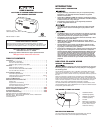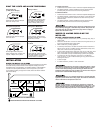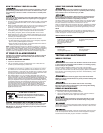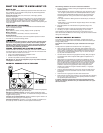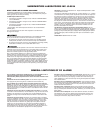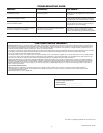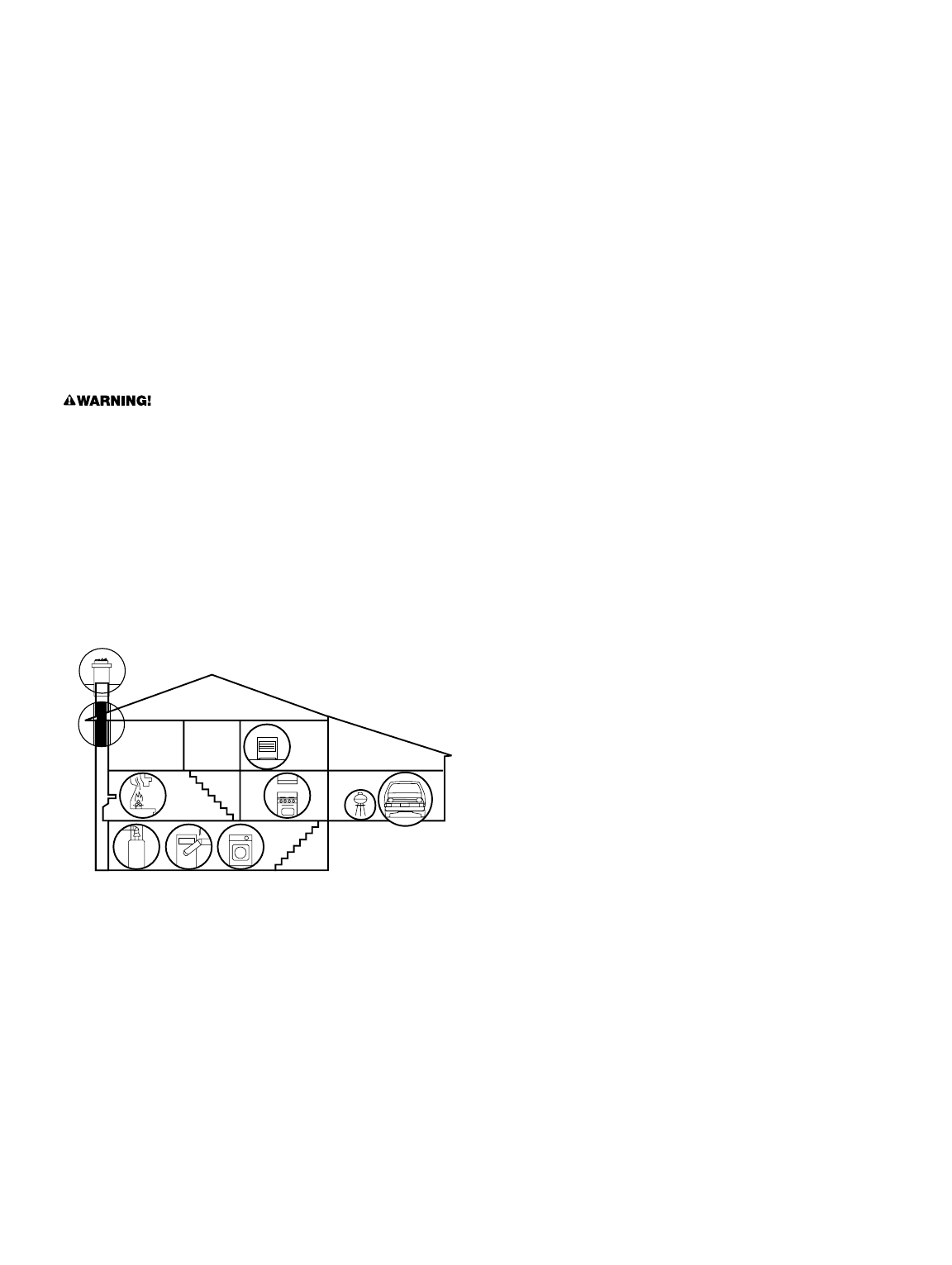
4
WHAT YOU NEED TO KNOW ABOUT CO
WHAT IS CO?
CO is an invisible, odorless, tasteless gas produced when fossil fuels do not
burn completely, or are exposed to heat (usually fire). Electrical appliances
typically do not produce CO.
These fuels include: Wood, coal, charcoal, oil, natural gas, gasoline,
kerosene, and propane.
Common appliances are often sources of CO. If they are not properly main-
tained, are improperly ventilated, or malfunction, CO levels can rise quickly.
CO is a real danger now that homes are more energy efficient. “Air-tight”
homes with added insulation, sealed windows, and other weatherproofing can
“trap” CO inside.
SYMPTOMS OF CO POISONING
These symptoms are related to CO POISONING and should be discussed
with ALL household members.
Mild Exposure:
Slight headache, nausea, vomiting, fatigue (“flu-like” symptoms).
Medium Exposure:
Throbbing headache, drowsiness, confusion, fast heart rate.
Extreme Exposure:
Convulsions, unconsciousness, heart and lung failure. Exposure to carbon
monoxide can cause brain damage, death.
Some individuals are more sensitive to CO than others, including people
with cardiac or respiratory problems, infants, unborn babies, pregnant
mothers, or elderly people can be more quickly and severely affected by
CO. Members of sensitive populations should consult their doctors for
advice on taking additional precautions.
FINDING THE SOURCE OF CO AFTER AN ALARM
Carbon monoxide is an odorless, invisible gas, which often makes it difficult
to locate the source of CO after an alarm. These are a few of the factors that
can make it difficult to locate sources of CO:
• House well ventilated before the investigator arrives.
• Problem caused by “backdrafting.”
• Transient CO problem caused by special circumstances.
BRK Brands, Inc. shall not be obligated to pay for any carbon monoxide
investigation or service call.
POTENTIAL SOURCES OF CO IN THE HOME
Fuel-burning appliances like: portable heater, gas or wood burning fireplace,
gas kitchen range or cooktop, gas clothes dryer.
Damaged or insufficient venting: corroded or disconnected water heater
vent pipe, leaking chimney pipe or flue, or cracked heat exchanger, blocked or
clogged chimney opening.
Improper use of appliance/device: operating a barbecue grill or vehicle in an
enclosed area (like a garage or screened porch).
Transient CO Problems: “transient” or on-again-off-again CO problems can
be caused by outdoor conditions and other special circumstances.
HOW CAN I PROTECT MY FAMILY?
A CO Alarm is an excellent means of protection. It monitors the air and
sounds a loud alarm before carbon monoxide levels become threatening for
average, healthy adults.
A CO Alarm is not a substitute for proper maintenance of home appli-
ances.
To help prevent CO problems and reduce the risk of CO poisoning:
• Clean chimneys and flues yearly. Keep them free of debris, leaves, and
nests for proper air flow. Also, have a professional check for rust and cor-
rosion, cracks, or separations. These conditions can prevent proper air
movement and cause backdrafting. Never “cap” or cover a chimney in
any way that would block air flow.
• Test and maintain all fuel-burning equipment annually. Many local gas or
oil companies and HVAC companies offer appliance inspections for a
nominal fee.
• Make regular visual inspections of all fuel-burning appliances. Check
appliances for excessive rust and scaling. Also check the flame on the
burner and pilot lights. The flame should be blue. A yellow flame means
fuel is not being burned completely and CO may be present. Keep the
blower door on the furnace closed. Use vents or fans when they are
available on all fuel-burning appliances. Make sure appliances are
vented to the outside. Do not grill or barbecue indoors, or in garages
or on screen porches.
• Check for exhaust backflow from CO sources. Check the draft hood on
an operating furnace for a backdraft. Look for cracks on furnace heat
exchangers.
• Check the house or garage on the other side of shared wall.
• Keep windows and doors open slightly. If you suspect that CO is escaping
into your home, open a window or a door. Opening windows and doors
can significantly decrease CO levels.
In addition, familiarize yourself with all enclosed materials. Read this
manual in its entirety, and make sure you understand what to do if your
CO Alarm sounds.
The following conditions can result in transient CO situations:
1. Excessive spillage or reverse venting of fuel appliances caused by outdoor
conditions such as:
• Wind direction and/or velocity, including high, gusty winds. Heavy air in
the vent pipes (cold/humid air with extended periods between cycles).
• Negative pressure differential resulting from the use of exhaust fans.
• Several appliances running at the same time competing for limited
fresh air.
• Vent pipe connections vibrating loose from clothes dryers, furnaces, or
water heaters.
• Obstructions in or unconventional vent pipe designs which can amplify
the above situations.
2. Extended operation of unvented fuel burning devices (range, oven,
fireplace).
3. Temperature inversions, which can trap exhaust close to the ground.
4. Car idling in an open or closed attached garage, or near a home.
These conditions are dangerous because they can trap exhaust in your
home. Since these conditions can come and go, they are also hard to recreate
during a CO investigation.



